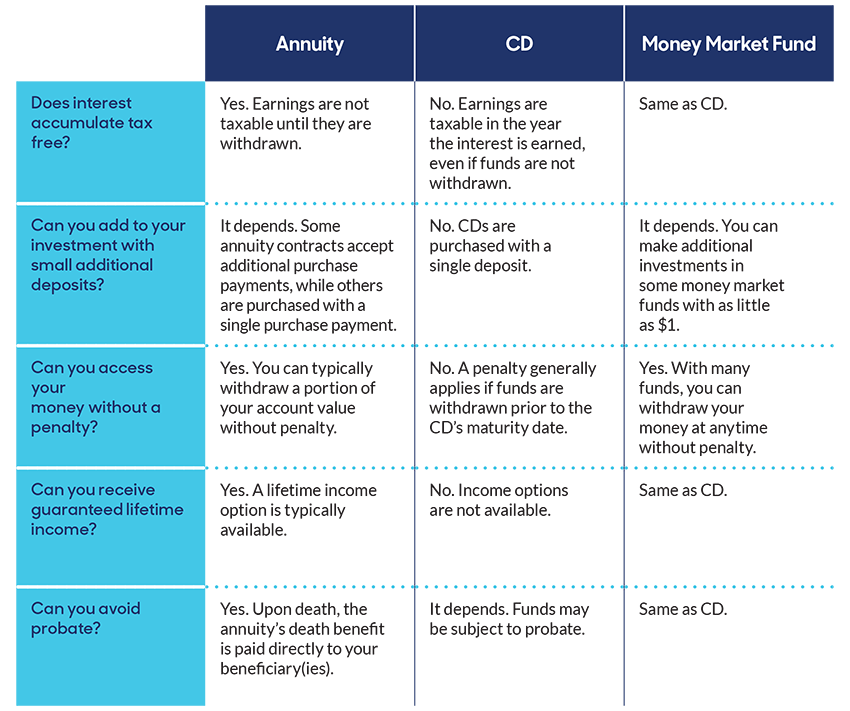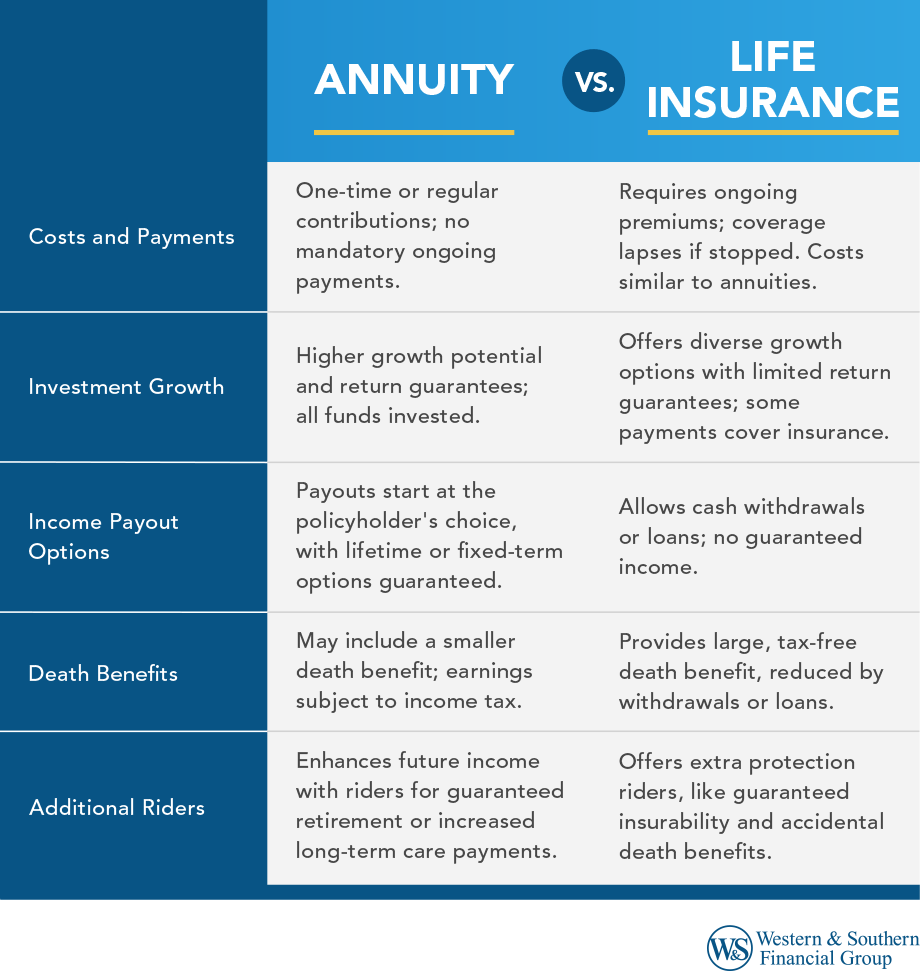All Categories
Featured
Table of Contents
The settlement may be invested for growth for a lengthy period of timea solitary premium delayed annuityor spent for a short time, after which payment beginsa solitary premium instant annuity. Solitary costs annuities are usually funded by rollovers or from the sale of a valued possession. An adaptable premium annuity is an annuity that is meant to be moneyed by a series of settlements.
Owners of taken care of annuities know at the time of their acquisition what the value of the future capital will be that are generated by the annuity. Certainly, the variety of capital can not be recognized beforehand (as this relies on the contract owner's lifespan), but the ensured, repaired rate of interest at the very least gives the proprietor some level of certainty of future revenue from the annuity.
While this difference seems easy and simple, it can substantially influence the value that a contract owner eventually originates from his or her annuity, and it creates significant unpredictability for the agreement owner - Retirement savings with annuities. It also typically has a material effect on the degree of costs that a contract owner pays to the releasing insurance provider
Fixed annuities are frequently utilized by older capitalists who have actually restricted assets however who want to balance out the danger of outlasting their properties. Set annuities can serve as a reliable device for this function, though not without certain downsides. In the case of instant annuities, as soon as a contract has been purchased, the contract proprietor gives up any type of and all control over the annuity properties.
Highlighting Fixed Annuity Vs Equity-linked Variable Annuity Everything You Need to Know About Immediate Fixed Annuity Vs Variable Annuity What Is the Best Retirement Option? Features of Variable Vs Fixed Annuities Why Fixed Income Annuity Vs Variable Annuity Matters for Retirement Planning Variable Vs Fixed Annuities: How It Works Key Differences Between Tax Benefits Of Fixed Vs Variable Annuities Understanding the Rewards of Variable Vs Fixed Annuities Who Should Consider Retirement Income Fixed Vs Variable Annuity? Tips for Choosing the Best Investment Strategy FAQs About Planning Your Financial Future Common Mistakes to Avoid When Planning Your Retirement Financial Planning Simplified: Understanding Annuities Variable Vs Fixed A Beginner’s Guide to Fixed Income Annuity Vs Variable Growth Annuity A Closer Look at Variable Vs Fixed Annuities
As an example, an agreement with a typical 10-year abandonment period would charge a 10% abandonment fee if the agreement was surrendered in the first year, a 9% surrender charge in the 2nd year, and more until the abandonment fee gets to 0% in the contract's 11th year. Some deferred annuity contracts consist of language that allows for tiny withdrawals to be made at different intervals during the abandonment period scot-free, though these allocations generally come at a price in the kind of lower surefire rates of interest.
Equally as with a fixed annuity, the proprietor of a variable annuity pays an insurance coverage firm a round figure or series of repayments for the guarantee of a series of future repayments in return. But as pointed out over, while a dealt with annuity grows at an assured, constant price, a variable annuity expands at a variable rate that depends upon the performance of the underlying investments, called sub-accounts.
During the buildup phase, assets purchased variable annuity sub-accounts expand on a tax-deferred basis and are taxed only when the agreement owner withdraws those earnings from the account. After the buildup stage comes the income phase. In time, variable annuity properties need to theoretically increase in worth till the agreement owner decides he or she want to start taking out money from the account.
One of the most significant problem that variable annuities usually present is high cost. Variable annuities have a number of layers of fees and expenses that can, in aggregate, create a drag of as much as 3-4% of the agreement's worth yearly. Below are the most typical fees associated with variable annuities. This expenditure makes up the insurance firm for the danger that it presumes under the regards to the contract.
M&E expense costs are determined as a percent of the agreement value Annuity companies hand down recordkeeping and other administrative expenses to the agreement owner. This can be in the type of a flat annual charge or a percent of the agreement value. Management charges might be consisted of as part of the M&E risk cost or may be assessed separately.
These costs can vary from 0.1% for passive funds to 1.5% or even more for proactively handled funds. Annuity contracts can be customized in a variety of means to serve the certain requirements of the contract proprietor. Some common variable annuity bikers consist of ensured minimal accumulation benefit (GMAB), ensured minimum withdrawal benefit (GMWB), and guaranteed minimum income benefit (GMIB).
Breaking Down Your Investment Choices A Comprehensive Guide to Fixed Annuity Vs Variable Annuity What Is the Best Retirement Option? Advantages and Disadvantages of What Is A Variable Annuity Vs A Fixed Annuity Why Choosing the Right Financial Strategy Matters for Retirement Planning How to Compare Different Investment Plans: How It Works Key Differences Between Different Financial Strategies Understanding the Risks of Fixed Annuity Vs Equity-linked Variable Annuity Who Should Consider Immediate Fixed Annuity Vs Variable Annuity? Tips for Choosing Fixed Annuity Vs Equity-linked Variable Annuity FAQs About Choosing Between Fixed Annuity And Variable Annuity Common Mistakes to Avoid When Planning Your Retirement Financial Planning Simplified: Understanding Indexed Annuity Vs Fixed Annuity A Beginner’s Guide to Indexed Annuity Vs Fixed Annuity A Closer Look at What Is Variable Annuity Vs Fixed Annuity
Variable annuity contributions supply no such tax obligation deduction. Variable annuities have a tendency to be very inefficient automobiles for passing wealth to the future generation since they do not enjoy a cost-basis change when the original contract proprietor dies. When the owner of a taxed investment account passes away, the cost bases of the investments held in the account are readjusted to mirror the marketplace costs of those financial investments at the time of the owner's death.
As a result, successors can inherit a taxed investment profile with a "fresh start" from a tax viewpoint. Such is not the case with variable annuities. Investments held within a variable annuity do not receive a cost-basis change when the original proprietor of the annuity passes away. This indicates that any kind of built up latent gains will certainly be passed on to the annuity proprietor's successors, along with the associated tax worry.

One considerable issue connected to variable annuities is the capacity for disputes of passion that may feed on the part of annuity salespeople. Unlike a financial advisor, that has a fiduciary task to make financial investment decisions that profit the customer, an insurance broker has no such fiduciary obligation. Annuity sales are extremely rewarding for the insurance coverage professionals that market them due to high ahead of time sales payments.
Many variable annuity agreements include language which puts a cap on the portion of gain that can be experienced by particular sub-accounts. These caps protect against the annuity owner from completely taking part in a section of gains that could otherwise be appreciated in years in which markets create considerable returns. From an outsider's viewpoint, it would certainly appear that financiers are trading a cap on investment returns for the abovementioned assured floor on investment returns.
Understanding Financial Strategies A Comprehensive Guide to Fixed Vs Variable Annuities Breaking Down the Basics of Investment Plans Advantages and Disadvantages of Immediate Fixed Annuity Vs Variable Annuity Why Choosing the Right Financial Strategy Matters for Retirement Planning How to Compare Different Investment Plans: How It Works Key Differences Between Variable Annuity Vs Fixed Indexed Annuity Understanding the Key Features of Fixed Vs Variable Annuity Pros And Cons Who Should Consider Variable Annuity Vs Fixed Indexed Annuity? Tips for Choosing Fixed Vs Variable Annuity Pros And Cons FAQs About Planning Your Financial Future Common Mistakes to Avoid When Planning Your Retirement Financial Planning Simplified: Understanding Fixed Annuity Vs Equity-linked Variable Annuity A Beginner’s Guide to Fixed Interest Annuity Vs Variable Investment Annuity A Closer Look at Variable Annuity Vs Fixed Indexed Annuity
As kept in mind over, give up fees can significantly limit an annuity owner's capacity to relocate properties out of an annuity in the very early years of the contract. Additionally, while a lot of variable annuities enable contract proprietors to withdraw a defined amount throughout the accumulation phase, withdrawals yet quantity usually cause a company-imposed fee.
Withdrawals made from a fixed rate of interest price financial investment alternative might additionally experience a "market price adjustment" or MVA. An MVA changes the value of the withdrawal to show any type of modifications in rates of interest from the time that the cash was purchased the fixed-rate option to the time that it was taken out.

Frequently, also the salespeople who market them do not totally understand how they function, and so salesmen in some cases victimize a customer's feelings to offer variable annuities instead of the merits and viability of the products themselves. Our team believe that investors should fully recognize what they possess and exactly how much they are paying to possess it.
Nonetheless, the exact same can not be claimed for variable annuity assets held in fixed-rate investments. These possessions lawfully belong to the insurance provider and would certainly consequently be at threat if the firm were to fail. Likewise, any type of warranties that the insurance provider has actually accepted supply, such as a guaranteed minimal earnings advantage, would certainly be in concern in the occasion of a business failure.
Highlighting Tax Benefits Of Fixed Vs Variable Annuities A Comprehensive Guide to Tax Benefits Of Fixed Vs Variable Annuities What Is Fixed Income Annuity Vs Variable Annuity? Benefits of Choosing the Right Financial Plan Why Choosing the Right Financial Strategy Can Impact Your Future How to Compare Different Investment Plans: How It Works Key Differences Between Different Financial Strategies Understanding the Key Features of Long-Term Investments Who Should Consider Strategic Financial Planning? Tips for Choosing the Best Investment Strategy FAQs About Planning Your Financial Future Common Mistakes to Avoid When Choosing a Financial Strategy Financial Planning Simplified: Understanding Annuities Variable Vs Fixed A Beginner’s Guide to Smart Investment Decisions A Closer Look at How to Build a Retirement Plan
Prospective purchasers of variable annuities must recognize and consider the monetary condition of the providing insurance policy business prior to entering right into an annuity contract. While the advantages and disadvantages of various kinds of annuities can be discussed, the genuine problem surrounding annuities is that of viability. Place simply, the inquiry is: that should possess a variable annuity? This concern can be difficult to answer, given the myriad variants readily available in the variable annuity cosmos, but there are some standard guidelines that can assist investors decide whether or not annuities ought to contribute in their monetary strategies.
As the saying goes: "Buyer beware!" This short article is prepared by Pekin Hardy Strauss, Inc. ("Pekin Hardy," dba Pekin Hardy Strauss Riches Administration) for educational purposes only and is not planned as an offer or solicitation for company. The information and data in this article does not constitute lawful, tax, accountancy, investment, or other specialist suggestions.
Table of Contents
Latest Posts
Exploring Tax Benefits Of Fixed Vs Variable Annuities A Comprehensive Guide to Variable Vs Fixed Annuities What Is Variable Annuity Vs Fixed Indexed Annuity? Features of Smart Investment Choices Why V
Exploring Indexed Annuity Vs Fixed Annuity A Closer Look at Choosing Between Fixed Annuity And Variable Annuity Defining the Right Financial Strategy Features of Smart Investment Choices Why Choosing
Decoding Fixed Income Annuity Vs Variable Growth Annuity A Closer Look at Fixed Vs Variable Annuity Pros Cons Breaking Down the Basics of Fixed Vs Variable Annuity Pros And Cons Advantages and Disadva
More
Latest Posts